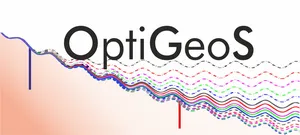Optimization of closed loop geothermal systems
Shallow geothermal energy is of crucial importance for a successful energy transition in the heating sector. This type of geothermal energy is mainly utilised via heat pumps, which are one of the key technologies when considering future CO2 reduction scenarios in the heating sector. The main shallow geothermal systems include borehole heat exchangers (BHEs), groundwater heat pumps (GWHPs) and two types of underground heat storage, borehole thermal energy storage (BTES) and aquifer thermal energy storage (ATES). It is to be expected that the number of near-surface geothermal systems will increase considerably in the future and that they will become an important component of future heating and cooling sectors, as they are more efficient than air-driven heat pumps and also offer the possibility of cooling and storage at the same time.
The overall aim of the project is therefore to develop an open source tool for optimising closed geothermal systems close to the surface (EWS, BTES).
The tool will contain two main functions:
Function 1: Optimisation of individual systems In order to make the best possible use of shallow geothermal systems, they must be optimally designed and controlled. This primarily includes the optimum number of boreholes, their length and placement as well as optimum volume flows of the heat transfer fluid. It is also important to optimise the combination of these systems with other systems such as solar thermal energy. Only through optimisation a maximum system efficiency can be achieved and negative effects on the environment can be minimised.
Function 2: Joint optimisation of multiple systems. As the use of shallow geothermal energy continues to grow, especially in urban areas, the number of installations is increasing and can reach a critical density. This means that negative interactions between neighbouring systems can occur, leading to reduced overall efficiency and regulatory problems. For this reason, a management tool is needed that can be used to find an optimal arrangement of systems, e.g. in an urban neighbourhood. This tool can then be used for optimal planning, but also for a more accurate assessment of the geothermal potential. In order to describe the interaction of geothermal systems with the subsurface, flow and heat transport in porous media are simulated numerically. These processes are described using partial differential equations (PDE). Therefore, the underlying problems are so-called PDE-constrained optimisation problems, which are highly complex multidisciplinary problems. In order to achieve the main objective mentioned above, this project will develop and apply solutions for these problems, i.e. for the optimisation of closed-loop near-surface geothermal systems. The main outcome of the project will be an open-source tool that can be used by various users from research and industry to optimise closed near-surface geothermal systems. The tool will be particularly important for planning offices and urban planners. Planning offices can use the new tool to optimise small and large systems in order to minimise overall costs or maximise overall efficiency and sustainability. Indirectly, this will also benefit future and existing system owners in terms of costs and security of supply. System planners can use the new tool to maximise the use of geothermal potential or to accurately assess the geothermal potential in the area under consideration.
Contributions to SDG
Funded by
Federal Ministry of Economics and Climate Protection (BMWK)
Partners
Chair of Renewable and Sustainable Energy Systems (TUM) (Lead of the project); Chair of Mathematical Optimization (TUM); geoENERGIEKonzept; Baugrund Süd
Responsible
Project duration
01.01.2024 – 31.12.2027



